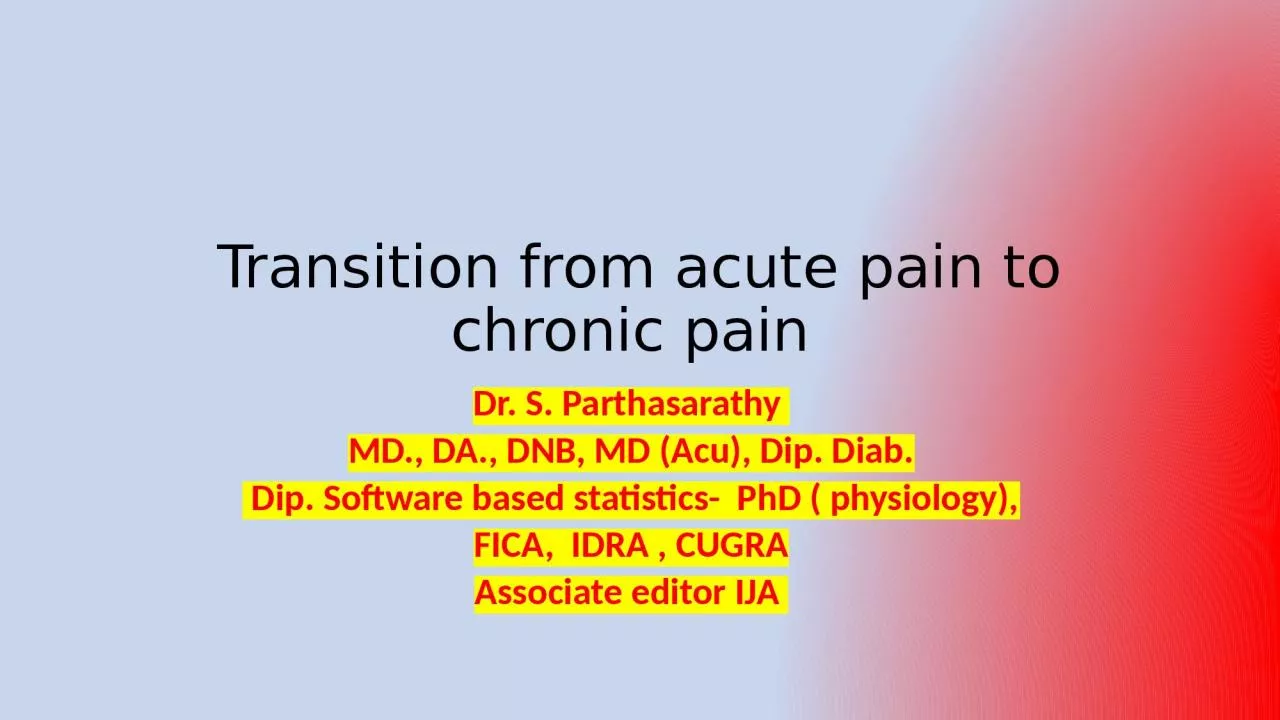

Dr S Parthasarathy MD DA DNB MD Acu Dip Diab Dip Software based statistics PhD physiology FICA IDRA CUGRA Associate editor IJA Topic to surgical exposures only Acute pain is an unpleasant sensory and emotional experience associated with actual or potential tiss ID: 935546
Download Presentation The PPT/PDF document "Transition from acute pain to chronic pa..." is the property of its rightful owner. Permission is granted to download and print the materials on this web site for personal, non-commercial use only, and to display it on your personal computer provided you do not modify the materials and that you retain all copyright notices contained in the materials. By downloading content from our website, you accept the terms of this agreement.
Slide1
Transition from acute pain to chronic pain
Dr. S. Parthasarathy
MD., DA., DNB, MD (
Acu
), Dip. Diab.
Dip. Software based statistics- PhD ( physiology),
FICA, IDRA , CUGRA
Associate editor IJA
Slide2Topic to surgical exposures only !
Acute pain is an unpleasant sensory and emotional experience associated with actual or potential tissue damage or described in terms of such damage
It has to heal by 12 weeks !!
Persist for 3 months !
Slide3What is CPSP ??
International Classification of Diseases defines CPSP as pain developing or increasing in intensity after a surgical procedure, in the area of the surgery, persisting beyond the healing process (
ie
, at least 3 months) and not better explained by another cause such as infection, malignancy, or a pre-existing pain condition
Slide4What is it actually !!
Consequence of surgery
Persists for more than 2 -3 months
No underlying disease found out
The preoperative pain should not have continued – not a continuum
Slide5Which surgeries cause CPSP ?
Inguinal hernia – 15 % ??
Breast surgeries - 50 %
Thoracotomies - 50 %
Lower limb amputation - 70%
Sternotomy - 30%
Pelvic fracture surgeries -30%
Some say – 5 – 55%
But overall moderate pain – 10 %
Slide6Its not simple pain !
Its not simple preoperative
pain
Increased intensity
Emotive component
Depression
Behavioural changes !!
Sometimes it happens with trauma
Its not as planned as surgery
It can happen even in children almost similar incidence
Slide7Risk factors - CPSP
Young females
Smokers
Obesity
Medical conditions
Preoperative pain
Long surgery
Psychological vulnerability
Ineffective acute pain relief
Nerve injury
Cut nerves !!
Slide8Pain genetics !
Pain genetics is a young, rapidly developing field.
It promises to account for trait variance in chronic pain states as well as vulnerability to developing chronic pain.
Individual differences are high in almost all chronic pain syndromes
Epigenetics is the study of heritable changes in gene expression caused by mechanisms other than changes in the underlying DNA sequence, namely DNA methylation and histone modification that bring about chromatin remodeling
Slide9Intensive care units
Slide10Periphery – what happens
Up-regulation of substance P,
phosphorylation of various enzymes (e.g. protein kinase A and C),
activation of transient receptor potential vanilloid (TRPV) receptor and purinergic
receptor,
increased responsiveness of the nociceptors, - retrograde neurogenic inflammation
activation of silent nociceptors.
changes potentiate nociception; leading to a state of ‘peripheral hypersensitivity’ and
hyperalgesia.
Slide11NE
PKC
Periphery
Slide12Central
Slide13In the brain ?
Systemic inflammation
Adrenergic surge
Other effects
+ noradrenaline stimulates nociceptors
Functional MRI studies have demonstrated changes in the
centres
of the brain matrix of patients with chronic pain.
Slide14Descending control – stimulate – pain ??
The PAG and the nucleus raphe magnus (NRM) emerged early on as key midbrain structures in opioid related endogenous pain modulation.
Electrical stimulation of the PAG in animals inhibits spinal nociceptive processing, and microinjection of opioids disinhibits inhibitory neurons in the PAG, accentuating descending anti-nociception
Slide15Descending control area diseased – no hyperalgesia
Slide16Prevention
Target the risk factors and beware
Careful tissue handling,
Prevent nerve damage
and minimal invasive surgical techniques (LAP) during surgery minimize tissue damage and potentially reduce the risk of chronic pain
Slide17Anesthetic influence
The surge is more on DAY 1
Rigorous multimodal
Study proved that epidural local with morphine – decreased the incidence of CPSP after breast surgeries
Preemptive analgesia
Simple local infiltration prior !
Peripheral nerve blocks with long duration
Intrathecal narcotics
TAP catheters
Slide18What's in the periphery ?
Local anesthetic infiltration
NSAIDS – role of caspase inhibition ! ( apoptosis and inflammation enzymes)
COX 2 inhibitors
Duloxetine
Glutamate modulators ?
Slide19Continuous good post op analgesia – outcome !!
Slide20Central prevention
Oxytocin
Alpha 2 agonists
Cannabinoids
Slide21Target each component
Pregabalin
Gabapentin
Valproate
Slide22Targets
Magnesium
Ketamine
Dextrometharphan
Slide23Capsaicin
Depletes substance p
Stimulates TRPV1 –
excessive calcium influx
Disruption of nociceptive
input
Ruthenium ,
capsezepine
Slide24Opioids
Slide25Other options
Ruboxistaurin
– PKC inhibitors
Tanezumab - NGF inhibitors
Adenosine monophosphate-activated protein kinase (AMPK) has recently emerged as a novel target for the treatment of pain with the exciting potential for disease modification- metformin and other new drugs
Non CPSP chronic pain syndromes
Slide26When it has come – assess all components biopsychosocial !!
Gabapentin, duloxetine ‘ziconotide
Purine antagonists
Neuro modulation – acupuncture , TENS
Slide27Severe cases
Neural blocks
Neurolytics
Radiofrequency ablation
PAG and opioids – are they used more ?
Slide28Slide29Slide30Slide31Slide32Summary
CPSP – what is it ? Why ?
Problem ?
When and which surgeries
Why – three targets
Chemicals and drugs
Transitional pain
centre
Thank you all